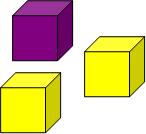Copyright © University of Cambridge. All rights reserved.
'Same or Different?' printed from https://nrich.maths.org/
Show menu
Why do this problem?
This problem provides a context in which pupils can explore the likelihood of events and therefore gain experience in using appropriate vocabulary.
Possible approach
You could set this problem up by acting it out with two children. Put three cubes, two of one colour and one of a different colour, in a bag and explain how the game works. Play a few times and ask the whole group to consider whether they think it is a fair game or not. Their answers may well depend on the outcomes of the games they have seen, for example someone may suggest that it is fair
because each child happened to win twice each. In other circumstances, someone may suggest it isn't fair because one child won more games than the other.
Ask learners what they would expect to happen if you played many, many more games. Give them time to think about this in pairs and have cubes available for them to work with should they want them. As the children discuss the problem, listen out for those who are looking at all the possibilities and analysing each in turn.
In the plenary, invite some pairs to share their methods and explanations for their solution. It would be helpful for them to write on the whiteboard as they talk so that the processes are recorded. Some may justify their answer in terms of numbers of possible ways that Anna/Becky can win. Some may have given probabilities in terms of fractions for each girl winning, but this is not
necessary for a full and convincing solution.
Key questions
What colour cube could Anna pick from the bag? What are Becky's options then?
What are all the different ways that two cubes could be taken from the bag?
Possible extension
Children could try In a Box which takes these ideas a bit further.
Possible support
Encouraging children to list all the different ways to pick out two cubes will help them access this problem.
